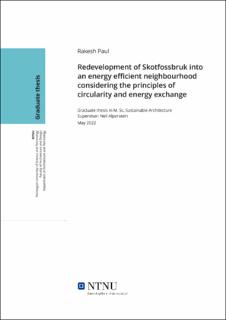| dc.contributor.advisor | Alperstein, Neil | |
| dc.contributor.author | Paul, Rakesh | |
| dc.date.accessioned | 2022-07-16T17:20:33Z | |
| dc.date.available | 2022-07-16T17:20:33Z | |
| dc.date.issued | 2022 | |
| dc.identifier | no.ntnu:inspera:113132537:68584858 | |
| dc.identifier.uri | https://hdl.handle.net/11250/3006174 | |
| dc.description.abstract | Skotfossbruk, en gang den største papirfabrikken i Nord-Europa og som har distribuert papirprodukter globalt, måtte stenge etter mer enn 70 år med vellykket drift. Startet i år 1892 pleide det å produsere en rekke produkter som innpakningspapir til avispapir for New York Times. Den nybygde Telemarkskanalen, sett på som verdens åttende underverk av europeere som ligger i nærheten av bruket, hentet inn råvarer fra den nærliggende Telemarksskogen og fungerte som en viktig rute for transport av mennesker, varer og husdyr. Det ligger i Skien kommune ved innsjøen Norsjø som etter byggingen av et vannkraftverk gjorde at industrien satt over sin kraftkilde. Et sviktende marked betydde nedleggelse av industrien med de siste produktene som ble avsluttet i 1986. I dag er industrien en del av en kultursti som forteller historier om den strålende fortiden. Denne artikkelen tar sikte på å omutvikle papirfabrikken til et nabolag som kan tiltrekke seg mennesker fra hele verden. Ved å redesigne restene av den gamle industrien for å foreslå nye bygninger, kan den bringe lokalsamfunn sammen og fremme ideen om en bærekraftig ombygging. Fremme gangbar infrastruktur og forbedre de romlige kvalitetene gir det rom for ulike aktiviteter. Nabolaget oppnår på å bli et netto nullenerginabolag gjennom lokal produksjon av energi gjennom fornybar energi. Siden det vil komme lite vannkraft i Norge i fremtiden, er det viktig å demonstrere selvforsyning i slike prosjekter som kan bli en prøveplass for andre nabolagsprosjekter. Sirkularitet i matsystemet har vært en kritisk del av dette nabolaget, siden det genererer en viss mengde energi for å dekke energibehovet. Lokalisering av matproduksjon i dette nabolaget betydde også at folk er klar over maten de konsumerer, og bygger bro mellom produksjon og forsyning. Nabolaget demonstrerte intern energiutveksling for å oppfylle energibehovet til bygningen først og deretter utveksle overskuddsenergien utenfor nabolaget. Gjennom nøye utforming og valg av riktige byggesystemer var nabolaget i stand til å redusere den totale energibelastningen og gjennom egenproduksjon var det i stand til å dekke energibehovet, noe som demonstrerte en vellykket utvikling av prosjektet. | |
| dc.description.abstract | Skotfossbruk, once the largest paper mill in North Europe and having distributed paper products globally had to close after more than 70 years of successful operation. Started in the year 1892 it used to manufacture a variety of products such as wrapping paper to newsprint for the New York Times. The newly constructed Telemark Canal, regarded as the 8th wonder of the world by Europeans located near the mill brought in raw materials from the nearby Telemark Forest and served as an important route for transporting people, goods, and farm animals. It is situated in Skien municipality next to lake Norsjø which after the construction of a hydroelectric power plant meant the industry was sitting over its power source. A failing market meant the closure of the industry with the last produce ending in 1986. Today the industry is part of a cultural trail that tells stories about the glorious past. This paper aims at redeveloping the paper mill to a neighbourhood that can attract people from all over the world. By redesigning remains of the old industry to proposing new buildings it can brings communities together and promote the idea of a sustainable redevelopment. Promoting walkable infrastructure and improving the spatial qualities it provides a space for various activities. The neighbourhood achieves on becoming a net zero energy neighbourhood through local production of energy through renewables. Since little hydropower will be coming in Norway in the future, it is important to demonstrate self-sufficiency in projects of this nature that can become a testing ground for other neighbourhood projects. Circularity in the food system has been a critical part of this neighbourhood, as it generates a certain amount of energy to fulfil the energy demand. Localisation of food production in this neighbourhood also meant that people are aware of the food they are consuming bridging the gap between production and supply. The neighbourhood demonstrated internal energy exchange to fulfil the energy demand of its building first and then exchanging the surplus energy outside the neighbourhood. Through careful designing and selection of right building systems the neighbourhood was able to reduce the overall energy load and through self-production it was able to cover its energy needs demonstrating a successful development of the project. | |
| dc.language | eng | |
| dc.publisher | NTNU | |
| dc.title | Redevelopment of Skotfossbruk into an energy efficient neighbourhood considering the principles of circularity and energy exchange | |
| dc.type | Master thesis | |
